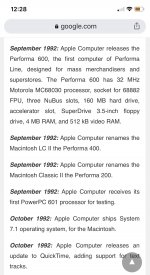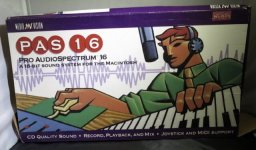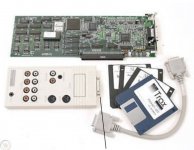Fair enough. (EDIT: w/re "new thread" - I started drafting this a few days ago and then got distracted and finally looked at this computer again.)
With re your screens in the first post, that doesn't mesh with how MacWorld was describing the P200/P400 - which were described same as the P600, alternate versions of extant Macs meant for superstore/bigbox retailers. Up front, Performas were framed as another option more than anything else.
If I had to guess, the original Grand Unifying Theory of Performa was that all Macs seen as relevant to consumers would be given Performa [number] names to position them within the family, because Classic, LC, and II don't "mean" anything to consumers who aren't already
into Macs specifically.
W/re the IIvx vs vi, it really seems like the best (hypothetical/fanfiction) play here would be to eliminate the VI and unless it let them cut hundreds of dollars off of the retail price, leave the 32k of cache on the motherboard for the resultant Performa.
I also floated the idea of the Mac
IIcd, which would be a IIci platform but perhaps with sound and the updated graphics and the new case, but once you casually "just" add sound-in and "just" add a new graphics subsystem, you're most of the way to basically the same amount of work it probably took to beef up the LC/II platform to this level.
I don't have the reference, unfortunately, but the lore I've heard (there was another IIvx/vi/P600 thread a few months ago, or, like, last year?) was that the development of this machine was primarily to respond to consumer demand for CDROM technology. So, there's another aspect to the unanswerable questions from yesterday as to whether a tall LCIII with a CD bay would have been the better machine for this market.
At the other end of this machine's life is the 650, which removes everything that was seen as a limitation and replaces it all with something as fast as or faster than a Quadra 700, with that third slot and the 5.25 bay, but the question of "what do people before that do, though?" lingers.
It feels like the competing factors of not wanting to significantly refactor a really old platform (the IIci was 3 years old at that point), wanting to respond to consumer demand as fast as possible, and wanting a chassis that was useful for more than just one generation are probably what produced the IIvx & co, as opposed to a double-tall LCII to fit a bigger power supply and a CD-ROM drive
With re the sound on the IIvx/P600 - again, the P600 sold for half what a IIci did, and was really based on the LC II's platform, not the IIci's platform, so I"m not super-duper surprised that the sound isn't all that great. It's a bit less excusable on the 630, I'd argue, and that heritage is, again, why the 6300 in mid-late 1996 still has like 1992's middlingest sound hardware.
In fact, "it's not actually based on the historic Mac II architecture" is also probably why the accelerator slot doesn't take cache cards like the IIci's does. This machine needs to be understood as having been been built up from a lower end but newer machine, not stripped down from the older and higher end IIci. Especially given all the stuff it's got that really is "new" in the context of 1989, like sound input and CDROM.
Gotta love how they cheaped out on the sound chip on a "multimedia" focused platform. This despite shipping machines with stereo 8-bit audio since at least the Macintosh II.
It took me a bit to figure out what you meant by this.
You're not wrong, except for the part where this machine inherits its sound from the previous LCs, along with the Classic/II.
On one hand: yeah, it's a bit of a bummer for a multimedia platform. On the other hand, what was the state of multimedia in 1992, really?
Not to do the thing I literally always do and be all "we need to think about the context

" but I
do think we need to think about the context. Most edutainment was still being designed with a single speaker that faces toward the table (in, i.e. the LC and IIsi) in mind, or a side-firing speaker like what the Classic/II had. This machine isn't a
production machine, it's purely for consumption and productivity appliance use cases, so, I think that the LC's dual-mono outputs was, yes, annoying, but also:
probably fine. The revolution of like "listening to music on your computer, specifically" wouldn't really happen until almost a decade later when hard disks were big enough to store a couple albums worth of MP3s and computers were fast enough to play back highly compressed audio formats.
As far as I can tell, the next major revision of the Performa 600 series, the 630, did have stereo, but it was 8-bit instead of 16-bit, which the production-oriented Macs and their down-market siblings (Quadra and Centris) had gone to. (which is sort of that weird spot that the 6300 is in in 1996 where you can still be dailying a 6300 in 1999 and you can upgrade the hard disk and then suddenly MP3s are a disappointment due to a decision made in 1993 or 1994.)







